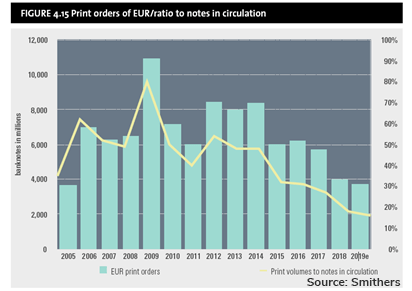Smithers identifies major shifts in security print sectors

The security print industry is adjusting to new market realities – in particular the wider use of e-payments and digital identity platforms that are threatening the long-term viability of core markets. The impact of these trends on personal ID and banknote production will have a limited impact across the five-year Smithers forecast period – and will be compensated for by growth in new sectors.
For the longer term, this is creating a degree of uncertainty, however. In response, established names in the private-sector security print segment are diversifying their product offering. In particular, there is interest in extending the role of traditional high security printers into service provision, including software and support for documents once in circulation.
Over the next five years there will be new imperatives and challenges for different segments of this market. Smithers’ analysis identifies the following as among the most significant.
Banknotes
Printed banknotes will remain the highest value segment of the overall security print industry through to 2024. There are new challenges for privately owned high-security printers (HSPs) in particular, however.
Overall, state printers already account for around 80% of banknote production and hold strong positions in the largest volume printers globally – such as China and India. This, combined with declining orders in developed markets, is putting pressure on commercial printers.

Caption: Improved durability and wider use of e-payments are contributing to a decline in orders for new banknotes of certain currencies, like the euro.
The new opportunities that do exist will be in developing markets with smaller countries that do not have state printing. There is some erosion of the banknote demand forecast for the future due to wider use of credit and debit cards, and mobile e-wallets, but penetration of these technologies is highly contingent on local infrastructure and national attitudes to cash.
Personal ID
For personal identity documents, electronic credentials and verification will be defining trends for the 2020s. Physical documents will continue to be issued – with only a few states, such as Estonia, taking concrete steps to cut transition towards truly online platforms. The trend in the medium-term will be for printed documents to be used less frequently and for a detectable slackening in demand for new physical components and printing. This is reflection of the reorientation of the personal ID industry to incorporate a range of new technologies that complete ID verification in the electronic realm.
Brand protection packaging
Despite a relatively small market share of the overall security print market, demand for smart and secure printed packaging makes this the second fastest-growing section of the market.
A key challenge is to develop effective solutions for use in packaging of goods sold via e-commerce, as this sales channel becomes increasingly popular with consumers and has long been used by sellers of counterfeit goods. As in other sectors, there is a move away from optical security features that are identical for each item they protect to digitally connected features that allow consumers and authorities to inspect the integrity of each item throughout its life journey.
The industry will also benefit from the rollout of compulsory traceability and tamper evidence features for pharmaceutical packaging.
Tax stamps
Legislation and international agreements are also driving new demand for printed tax stamps – especially for tobacco, but other goods as well.
The ratification of the World Health Organization’s (WHO) Framework Convention on Tobacco Control (FCTC) Protocol in late 2018 means that by 2023 all 168 signatory states must introduce a track-and-trace system for cigarettes by 2023. This is poised to make tax stamps the fastest growing security document type across the next five years. Guidance on the new generation of tax stamps is given in the recently issued ISO 22382 standard.
Tobacco stamps are seeing a more immediate boost in demand from the EU’s revised Tobacco Products Directive (TPD) 2014/40/EU.